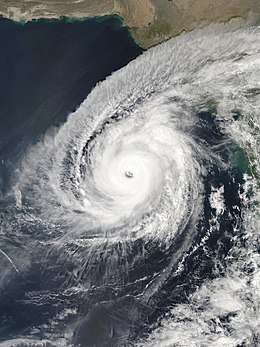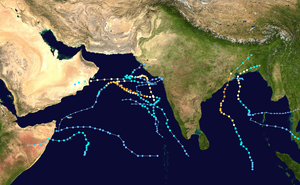Cyclone Kyarr
Super Cyclonic Storm Kyarr was an extremely powerful tropical cyclone that became the first super cyclonic storm in the North Indian Ocean since Gonu in 2007. It was also the second strongest tropical cyclone in the Arabian Sea and one of the most intense tropical cyclones in North Indian Ocean history.[1] The seventh depression, fifth named cyclone, and the first, and only super cyclonic storm of the annual season, Kyarr developed from a low-pressure system near the Equator. The system organized itself and intensified to a tropical storm on October 24 as it moved eastwards. The storm underwent rapid intensification and reached super cyclonic storm status on October 27, as it turned westwards.
| Super cyclonic storm (IMD scale) | |
|---|---|
| Category 4 tropical cyclone (SSHWS) | |
 Kyarr near peak intensity on October 27 | |
| Formed | October 24, 2019 |
| Dissipated | November 3, 2019 |
| (Remnant low after November 1) | |
| Highest winds | 3-minute sustained: 240 km/h (150 mph) 1-minute sustained: 240 km/h (150 mph) |
| Lowest pressure | 922 hPa (mbar); 27.23 inHg |
| Fatalities | None |
| Damage | Unknown |
| Areas affected | Western India, Oman, United Arab Emirates, Socotra, Somalia |
| Part of the 2019 North Indian Ocean cyclone season | |
Despite the immense strength of the storm, and many countries being affected by high tides and storm surges, there were no reported fatalities.
Meteorological history

A low pressure area formed on October 17 in the Arabian Sea west of India near the Lakshadweep islands. Around that time, the India Meteorological Department (IMD) anticipated that the low would eventually develop into a tropical cyclone. The low remained in the same general region for a few days, becoming well-marked by October 22. The IMD classified the system as a depression early on October 24, upgrading it to a deep depression by later that day. [2] On the same day, the Joint Typhoon Warning Center (JTWC) began issuing warnings on the system, classifying it as Tropical Cyclone 04A.
The deep depression initially moved to the northeast toward the west coast of India. Early on October 25, the IMD upgraded the system to a cyclonic storm, naming it Kyarr. Later that day, the storm turned northward and intensified further to a severe cyclonic storm.[2] Warm water temperatures of around 28 °C (82 °F), as well as low wind shear, fueled rapid intensification.[3] Kyarr turned to the northwest away from India on October 26. On the same day, the IMD upgraded the storm to a very severe cyclonic storm and later to an extremely severe cyclonic storm. Early on October 27, the IMD upgraded Kyarr further to a super cyclonic storm, the first one in the basin since Gonu in 2007; it was also the only recorded super cyclonic storm in the Arabian Sea to occur after the monsoon season.[2] Both the IMD and the JTWC estimated peak maximum sustained winds of 240 km/h (150 mph), with a minimum central pressure of 922 mbar (27.2 inHg) estimated by the IMD.[2][4] Operationally, the JTWC estimated slightly higher winds of 250 km/h (155 mph).[3]
At its peak, Kyarr had a well-defined eye, surrounded by well-defined rainbands and outflow.[5] For about 12 hours, Kyarr maintained peak intensity, although it remained a super cyclonic storm for about 51 hours while moving toward the Arabian Peninsula. On October 30, the storm began weakening as the track shifted to the west, falling to the intensity of a severe cyclonic storm. On the same day, Kyarr co-existed with Cyclonic Storm Maha, marking the first time on record that there were two simultaneous cyclonic storms in the Arabian Sea. Kyarr turned to the southwest, paralleling the coastline of the Arabian Peninsula offshore. On October 31, it weakened to a deep depression, and Kyarr deteriorated further to a depression on the next day. The circulation passed just north of Socotra on November 2, and shortly thereafter weakened into a remnant low off the northern coast of Somalia.[2]
Preparations and impact
Due to the large circulation of the cyclone, the IMD recommended all fishermen avoid sailing in the Arabian Sea for five days. The Indian Coast Guard rescued at least 19 fishermen caught by the storm.[6] The Indian Navy rescued 17 fishermen from a boat that sank amid high seas west of Mumbai.[7] On October 24, Kyarr washed ashore the chemical tanker Nu-Shi Nalini near Dona Paula in Goa state, which was carrying naphtha, an explosive. The material was salvaged about a month after the storm, and was eventually shipped in early January 2020.[8] Also offshore, the cyclone forced two AIDA cruise ships to reroute their paths.[9]
In advance of the tropical cyclone, the IMD issued rain and surf alerts for the Indian states of Maharashtra, Karnataka, and Goa.[10] As Kyarr approached western India, the cyclone dropped heavy rainfall onshore, peaking at 400 mm (16 in) in Malvan, Maharashtra.[2] In Goa, the rains caused flash flooding, while strong winds felled trees and power lines.[10] In Mumbai, the storm's heavy rains contributed to a dengue outbreak, with a 70% increase in cases of the mosquito-borne disease in December 2019 compared to the same month in 2018.[11] In Gujarat, more than 157,000 farmers filed insurance claims due to damage related to Kyarr, with most of the losses related to groundnut and cotton. The state government reimbursed farmers for their losses.[12][13]
In southern Pakistan, officials closed beaches and opened four shelters due to high tides from the cyclone. Floods affected parts of Karachi, closing a section of Defence Raya Golf and Country Club.[14]
High tides from Kyarr flooded towns on the coast of Oman.[15] In neighboring United Arab Emirates, high tides flooded streets, houses, and schools in eastern coastal areas of Sharjah and Fujairah.[16] Heavy rainfall from the outskirts of Kyarr also caused flooding in Dubai.[9]
Kyarr started to slow down as it moved through the Arabian Sea, and it dissipated before reaching Socotra Island.[17][18]
See also
References
- Cappucci, Matthew (28 October 2019). "Category 4 Kyarr is the strongest cyclone over the Arabian Sea in 12 years". The Washington Post. Archived from the original on 28 October 2019. Retrieved 28 October 2019.
- Super Cyclonic Storm ‘Kyarr’ over the Arabian Sea (24th October – 02nd November 2019): Summary (PDF) (Report). India Meteorological Department. Retrieved June 6, 2020.
- Bob Henson. "Kyarr Nears Cat 5 Strength in Arabian Sea; Pablo a Hurricane; California Faces Hellish Sunday of Fire". Retrieved June 6, 2020.
- "04A Kyarr Track File" (TXT). Joint Typhoon Warning Center. Retrieved June 6, 2020.
- Matthew Cappucci (October 28, 2019). "Category 4 Kyarr is the strongest cyclone over the Arabian Sea in 12 years". The Washington Post. Retrieved June 6, 2020.
- "Cyclone Kyarr intensifies to super cyclonic storm, Coast Guard on alert". The Hindustan Times. October 27, 2019. Retrieved June 6, 2020.
- "Cyclone Kyarr: Navy Rescues 17 Fishermen From Sinking Boat Near Mumbai". All India. October 27, 2019. Archived from the original on October 29, 2019. Retrieved October 29, 2019.
- "2,400 tonnes of naphtha taken out of Goa, shipped to Gulf". Times of India. January 1, 2020.
- "Unstable weather causes itinerary changes for UK cruise ship in Dubai". Middle East Logistics. November 17, 2019. Retrieved June 11, 2020.
- "Cyclone Kyarr, Weather forecast today LIVE Updates: Super cyclone moves towards Oman coast". The Indian Express. 2019-10-28. Archived from the original on 2019-10-28. Retrieved 2019-10-28.
- "Seasonal sting in the tail; Protracted rains led to rise in dengue, dengue-like illnesses Health experts". The Free Press Journal. January 8, 2020. Yahoo! News. Retrieved June 11, 2020.
- "Gujarat: Over 1.57 lakh farmers claim insurance after October's unseasonal rain damaged crops". The Indian Express. November 7, 2019. Retrieved June 12, 2020.
- https://indianexpress.com/article/cities/rajkot/vijay-rupani-will-compensate-farmers-for-crop-loss-6108683/
- "Coastal areas flooded as cyclone Kyarr intensifies". October 29, 2019. Archived from the original on October 29, 2019. Retrieved October 29, 2019.
- "Cyclone Kyarr: Oman feet-deep in flood water with more on the way". Archived from the original on 2019-10-29. Retrieved 2019-10-29.
- "UAE roads closed: 'Unusually high tide, flooding' as Cyclone Kyarr kicks up waves". Archived from the original on 2019-10-29. Retrieved 2019-10-29.
- "Kyarr 2019 – Hurricane And Typhoon Updates". blogs.nasa.gov. Archived from the original on 2020-02-20. Retrieved 2020-02-20.
- "TROPICAL CYCLONE KYARR Tracker | Cyclocane". www.cyclocane.com. Archived from the original on 2019-11-22. Retrieved 2020-02-20.
External links
| Wikimedia Commons has media related to Cyclone Kyarr. |
- India Meteorological Department
- 04A.Kyarr from the U.S. Naval Research Laboratory
